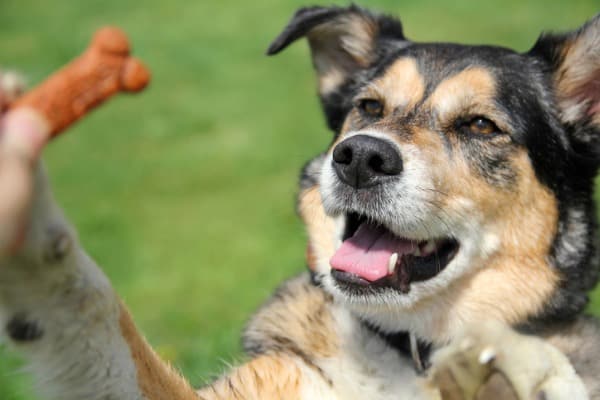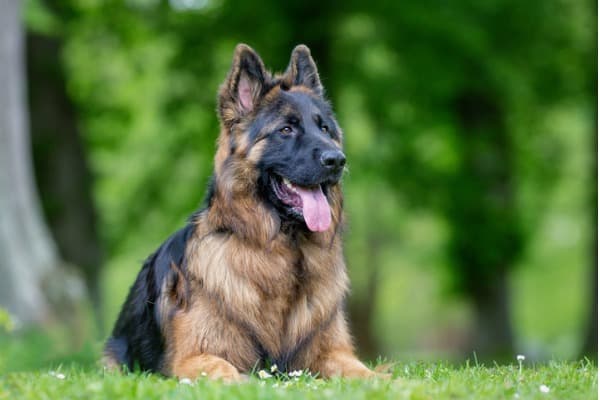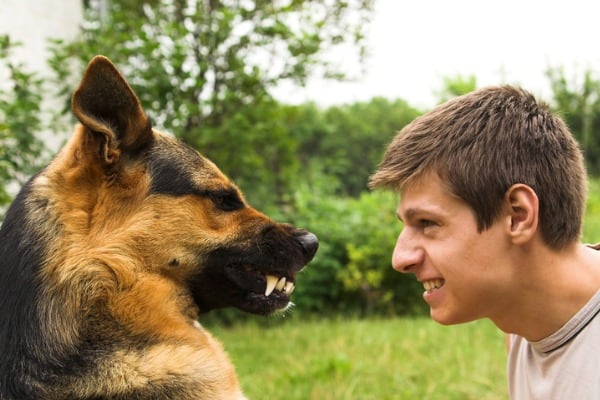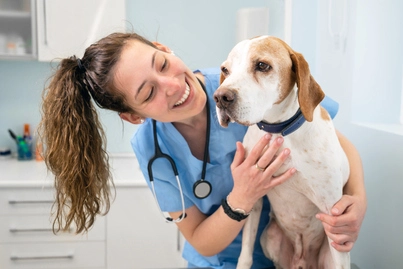A unique mixed breed that dog lovers might encounter is the Boxer German Shepherd mix.
These two large breed dogs can combine into a truly incredible hybrid.

On the one hand, you have the German Shepherd dog, or GSD for short.
They are among the most lovable, loyal, and beautiful breeds.
Their high intelligence and eagerness to please make them highly trainable.
From family companions to military dogs, GSDs are extremely versatile additions to many environments.
Do we sound biased?
Guilty. We have a lot of experience with this breed and don’t have a lot of negative thoughts about them.
On the other hand:
We have the Boxer. Equally affectionate and handsome, the breed has worked its way into many hearts.
Together we have a Boxer Shepherd mix!
Each breed brings many excellent features to the table, so combining the two can make for a truly remarkable dog.
While both types of dogs make great family members, what should you look out for if you have a hybrid or are considering rescuing one?
Is this hybrid a good fit for your family? Let’s dig a little deeper and find out.
Half-and-half
In the past, words like “mix” and “mutt” were synonymous with low quality.
Hybrid breeds have gone above and beyond in proving themselves to be just as good as their purebred counterparts.
These days, dog enthusiasts have no issue with welcoming a mixed-breed dog into their home.
If you’re someone who has considered adding a Boxer GSD hybrid to your pack, there are a few things you should familiarize yourself with first.
So what’s the result when a Boxer and GSD mix their genes?
The results can vary, so to better answer that question, we have to take a closer look at each breed individually.
Boxers

Predecessors to modern-day Boxers can be traced back as far as 2,500 years ago.
The origins of the breed are indeed old. What we see today with the breed comes from the same place as the other breed we’re covering in this article: Germany.
Originally bred as game-hunting dogs, they eventually came to be popular pets.
Ever wonder why they’re called Boxers? They earned the name because of the way they “spar” when playing (or fighting).
Their large, formidable stature made them popular as guard dogs, but their playful personality is what earned them a spot as one of the most sought-after companion dogs.
They might be big, but they’re one of those dogs that will like to cuddle with close family members – maybe even in your lap.
With males reaching up to 80 lbs fully grown and females weighing in at up to 65 lbs, they’re not your typical lap dog.
Boxers are considered short-haired dogs, and their coat can come in a variety of colors.
The markings can be fawn or brindle and can be tan to dark brown.
Their ears are naturally “floppy” and not erect, although the trend of cropping the ears causes them to stand upright.
Docked tails were once very popular with this breed, but along with ear cropping, this practice is now deemed unnecessary.
No health benefit:
Tail docking and ear cropping are purely cosmetic, and the procedure is actually illegal in some countries. Many US vets recommend against it, as it offers no health benefits.
With the recent scrutiny regarding these cosmetic procedures, you’re more likely to see a dog with natural ears and tail.
Boxers are brachycephalic, meaning they have the “squashed face” features that are also seen in Pugs, and certain bully breeds, to name a few.
This facial structure makes them less tolerant of high heat and humidity.
When socialized with other dogs and people from an early age, Boxers have the potential to be social butterflies.
They will have an instinctive drive to guard their family and territory, but with proper training, they can be incredibly friendly.
Boxers have high energy and need plenty of exercise. Most will love a good game of fetch and require daily mental stimulation to keep them from getting bored.
German Shepherd Dogs

They’re the kings and queens of the canine empire – or at least, they think they are. GSDs have strong personalities that go hand-in-hand with sharp minds.
They started out as a herding breed but quickly became popular police, military, and guard dogs.
From their German homeland, GSDs were brought to America around the early 1900s.
Since then, they worked their way up the ranks to the second most popular dog in the US.
Along the way, it was discovered that these dogs make stellar companions. They will protect you with their lives but have the capacity to be very cuddly and loving.
Other popular German Shepherd mixes include:
- German Shepherd and Rottweiler mix
- German Shepherd and Poodle mix
- German Shepherd and Husky mix
- German Shepherd and Border Collie mix
- German Shepherd and Corgi mix
- German Shepherd and Chihuahua mix
Like the Boxer, your lap will be one of their favorite places. Since they can range from 70-90 lbs, sleeping arrangements can be taxing.
GSDs have thick fur, which is made up of a fluffy undercoat and guard hairs.
The guard hairs make up the outer layer of the coat, which protects them from the elements.
The thick coat makes them well suited for colder weather, but can also act as an insulator against high heat.
Some German Shepherds are long-haired, although this is a rare genetic anomaly.
While the classic coloring includes the dark “saddle” markings coupled with tan to reddish colors, they can be solid white or black as well.
The ears are naturally erect, and their sharp faces bring to mind wolf-like features seen in only a few other breeds.
GSDs are very alert dogs, and they don’t miss much happening around them.
Their sharp hearing and sensitive noses make them excellent for search and rescue work.
They love to be physically active.
They excel in agility courses, and some even love to swim.
But their mind needs just as much exercise. “Brain games” and puzzle toys are a must for any GSD, but particularly one that’s left to their own devices for long stretches.
The Two Breeds Together
So, just what can you expect when you combine these breeds?
Because genetics have an ultimate say in which traits will come out on top, it’s hard to guess.
There are some things you can be reasonably sure of when dealing with a Boxer-GSD hybrid.
They’ll Be Big
Even smaller specimens of each breed will likely exceed 60 lbs. So when you mix two large breed dogs, you’ll get a big result.
Unless, of course, you have a miniature German Shepherd in the mix!
The markings and coat of a GSD can be particularly dominant traits when they’re mixed with another dog.
The fur could be thick or something in between the short hair of a Boxer and the fluffiness of a GSD.
The same goes for coloring.
You might see familiar GSD markings or a mix of brindle and fawn.
One breed has naturally relaxed ears, and the other has upright ones. This can result in one ear up, one ear down situation.
Or, they could take after one parent entirely.
It’s important to note that since docking of the tail or cropping ears is not necessary to begin with, interfering with the physiology of a mixed-breed dog is not recommended.
Since both breeds have a reputation as guard dogs, you can expect them to be protective.
It’s also worth noting that both can be vocal, so barking and howling shouldn’t come as a surprise – especially when they’re trying to alert you of something or greeting you.
Boxers and GSDs face their own potential health issues. One issue that they share is the risk of hip dysplasia.
Getting to know the individual health issues that can come with each breed is the best way to prepare for problems a hybrid could face.
Big Dogs With Big Personalities
The temperament of a Boxer Shepherd mix will be largely influenced by their training.
In the case of a rescue, their background can also shape how they will act.
The Big Question: Are They Aggressive?

As mentioned before, both breeds will feel it is their duty to guard you, the home, and other household members.
Socializing them early on will help them become comfortable with other people and dogs.
If they have good experiences in various situations, they can become great playmates for children and other dogs alike.
Dog parks and regular walks are both great ways to socialize them and give them enough life experience that they won’t be overly protective.
GSDs, in particular, have had a bad reputation in the past as being aggressive.
While their bite can inflict serious injuries, they are one of the most misunderstood breeds when it comes to aggression.
In fact, the common “German Shepherds are aggressive” trope has been largely debunked by veterinarians and dog behaviorists alike.
For starters, GSDs rarely attack family members – many bites reported are the result of an attempted break-in or attack by the bad guys.
A GSD or any dog with shepherd DNA is far more likely to bite an intruder than their family.
Many reported bites were a result of abuse or mistreatment – it is extremely rare for any dog to bite unprovoked.
Boxers can also intimidate some people because of their size and tendency to avoid strangers.
While they can be standoffish to people they don’t know, they’re not known for being overly aggressive.
In the case of any dog, proper socialization, gentle yet firm training, and zero abuse are all the ideal recipes for a dog you can fully trust.
There is no evidence to support aggression is wired into any dog breed’s DNA.
In reality, you’re more likely to be bitten by a smaller-breed dog. A number of factors cause them to learn aggressive behaviors more often than their larger cousins.
Small dog bites often go unreported, which is why many people are more frightened of bigger dogs.
Provided a Boxer GSD hybrid isn’t abused, and the owner spends plenty of time on training, there’s no reason to believe they’re more likely to be aggressive than any other dog.
Even if you rescue such a hybrid from an abusive situation, there are plenty of ways to rehabilitate them.
One thing we want to mention, as experienced GSD parents: they can have a high prey drive.
It’s a head-scratching thing to observe when one GSD likes to chase cats as a sport while another will mother them.
The same goes for any smaller pets.
Some shepherds will want to herd and chase, and others can be trusted with other pets.
Get to know which side your hybrid takes after before leaving them around smaller animals.
If you’re thinking of adopting one and have smaller animals in your house, be aware that it could become an issue if your hybrid has a high prey drive.
Exercise is Your (Second) Best Friend
Both dog breeds have some demanding exercise requirements – and both will make their displeasure known if they get bored.
If they have too much pent-up energy, they will destroy your belongings in record time.
While smaller homes and apartments aren’t a deal-breaker, you’ll need access to open spaces and areas appropriate for daily walks.
A large breed mix such as this one needs, at a minimum, an hour of exercise per day – two short walks and a longer one are ideal.
The more you exercise them and burn off all that big dog energy, the better they will respond to training and house rules.
Indoor play can be almost as good as time spent outdoors.
Interactive toys can provide hours of entertainment and mental stimulation.
You don’t need special equipment to keep these types of dogs occupied, though.
The intelligence of Boxers and GSDs means they can figure out how to play hide-and-seek, and for many, it’s their favorite game.
They will also enjoy tug-of-war with you or other dogs and can benefit from heavy-duty chew toys.
Scent training is another great mind – and nose – exercise. Hiding treats throughout the house is great fun for these breeds.
A Quick Note
We’re speaking purely from experience here – German Shepherds can be massive wimps.
It might surprise you that they’re not always the big, brave dogs that popular culture makes them out to be.
They can be terrified of cats, thunder, and vacuums, to name a few.
By terrified, we mean they’ll hide somewhere and then pout for hours if they’ve been frightened.
Nail clippers?
They might as well be monsters masquerading as a benign grooming tool.
Produce a pair of clippers, and they will become a drama queen in an instant.
So any hybrid that includes GSD genes can produce a dog with the ability to be a big baby.
Training Tips
When two intelligent breeds come together, proper training is a must. It’s the best thing you can do for any dog, but particularly those with high IQs.
Start in the Park

This is especially true for puppies. We’ve mentioned several times that socialization is important for a Boxer GSD mix.
Early exposure to other dogs and people will help prevent unwanted protective behavior as they grow into adolescence and adulthood.
Like any puppy, it’s important not to overwhelm them.
Other dogs can be scary.
If your dog park has space for puppies and smaller dogs, that’s a good place to begin before graduating from the big dog section.
Friends and families with well-trained dogs can provide the perfect opportunity for a puppy to meet new friends.
Being around other well-trained dogs also gives puppies a chance to learn by example.
When they see another dog’s good behavior is rewarded, it can help encourage them to display good manners.
Controlled environments are best – always be sure you can remove a dog from the situation if they become too scared or if another dog becomes overbearing.
Let Them Meet New People
Any trusted friends or family who want to meet a new dog can do the dog a lot of good.
The more people they’re exposed to, the less likely they are to guard you or your home unnecessarily.
Dogs take cues from their people, so whisking them away or closing them off from visitors isn’t helping to teach them that guests are no reason to go berserk.
Reward Liberally
Since we’re talking about a hybrid of two smart breeds, it won’t take them long to figure out the good behavior and reward system.
In early training, treat early – treat often. Reward all good behaviors with praise as well.
Rather than punishing bad behavior, redirect to something acceptable.
Chewing your shoes can be redirected to chewing on an acceptable toy, for example. Similarly, redirect hyperness with a game of fetch or tug.
Never use corporal punishment to deter bad behavior. It will only teach your dog to be frightened, avoid you, and it could encourage aggression.
Start Leash Training Early
Since this hybrid can grow to be very large and powerful, poor leash manners can spell trouble if you put off-leash training.
A German Shepherd Boxer mix puppy is easy to control on the leash, but a full-grown one could take you for a painful ride down the sidewalk if they don’t know how to heel.
Proper leash and heel etiquette are something you’ll want to start ASAP.
Care and Grooming
Is there anything unusual about the care needs of this type of hybrid?
Not exactly – but you should be prepared for some possibilities.
Baths and Brushing
For a Boxer Shepherd mix, grooming is fairly straightforward.
If the hybrid takes after the GSD side of the family, regular brushing – think once a week – will be needed to care for their coat.
You might have a shedder on your hands if this is the case, so be prepared to do a lot of coat raking and vacuuming during the shedding season.
If they have a short coat, they’ll need very little brushing.
In either case, periodic baths and nail trims will be necessary – provided your dog cooperates with the nail clippers.
If not, it can be done at the vet’s office in under ten minutes.
Dietary Needs
Big dogs need big meals, so be ready to spend a lot on dog food.
Since a Boxer GSD hybrid needs a lot of exercise, their food should be high in protein and low in carbs and starchy fillers.
German Shepherds have some of the most sensitive stomachs of any dog, and their food should be selected carefully.
So if the hybrid favors the GSD parent, you might run into some food sensitivities or even allergies at some point.
Luckily, research on this issue has made leaps and bounds in recent years.
So even an allergy can be easily remedied by understanding the nutritional needs and adjusting the diet.
Health
The biggest thing you’ll want to look out for in this mix is hip dysplasia.
Each half of this hybrid is more prone to it than many other breeds.
This condition is something your vet should screen for so that any symptoms can be caught and treated early on.
Connect with a verified veterinarian in minutes. No waiting for appointments or office hours. No high fees. Your pet's health made convenient and worry-free.
If you take away only one thing from these recommendations, let it be this: Large dogs, but Boxers especially, are more prone to a serious condition called bloat.
Their barrel-chested trait puts them at added risk, so pay close attention to the signs: restlessness, attempts to retch or pass wind without producing either, and a distended abdomen.
Any of these symptoms warrant an emergency trip to the vet.
To help negate risks, feed your dog in several smaller meals rather than one large one per day.
Keep food dishes on the floor – no elevated bowls. Avoid heavy exercise for an hour before and after meals.
What to Expect from This Hybrid
How can they look? How big are they? What specific training methods are recommended?
See for yourself.
Is This the Hybrid for You?
Do you have time and patience to devote to a high-energy dog, access to parks, and a lot of love in your heart?
Did you answer a resounding yes to those questions?
Then this could be the perfect mix-breed dog for you.
Boxer German Shepherd mix puppies aren’t often for sale – they’re not a popular hybrid like the Goldendoodle.
You’re more likely to find one through a shelter or rescue organization, to which we say, all the better.
Don’t let their murky past put you off.
Even if they came from an abused home, they could still make an amazing addition to your family.
Proper desensitization and rehab, sometimes with the help of a trainer, can transform them into a perfect, lovable companion.
Beware of backyard breeders and puppy mills. Puppies should come with a certificate of health, and the breeder should do proper health screening on all dogs.
These things add to the price of well-bred dogs, so if you’re looking to buy one, you might be spending a lot.
If they come from a reputable breeder, they’re a dog that will be worth your while.
Two Distinct Breeds, One Special Mutt
If you already have one of these dogs in your life, you know they can present some challenges – but their kind and gentle personalities make it all worth your while.
If you’re thinking of expanding your pack to include a Boxer German Shepherd mix?
You’re in for some surprises, but good ones.
As long as you know what you’re signing yourself up for, then everything you’ll come to learn about this hybrid will be sure to make you smile.
We think sugar must be an ingredient in this hybrid because they’re so darn sweet.

